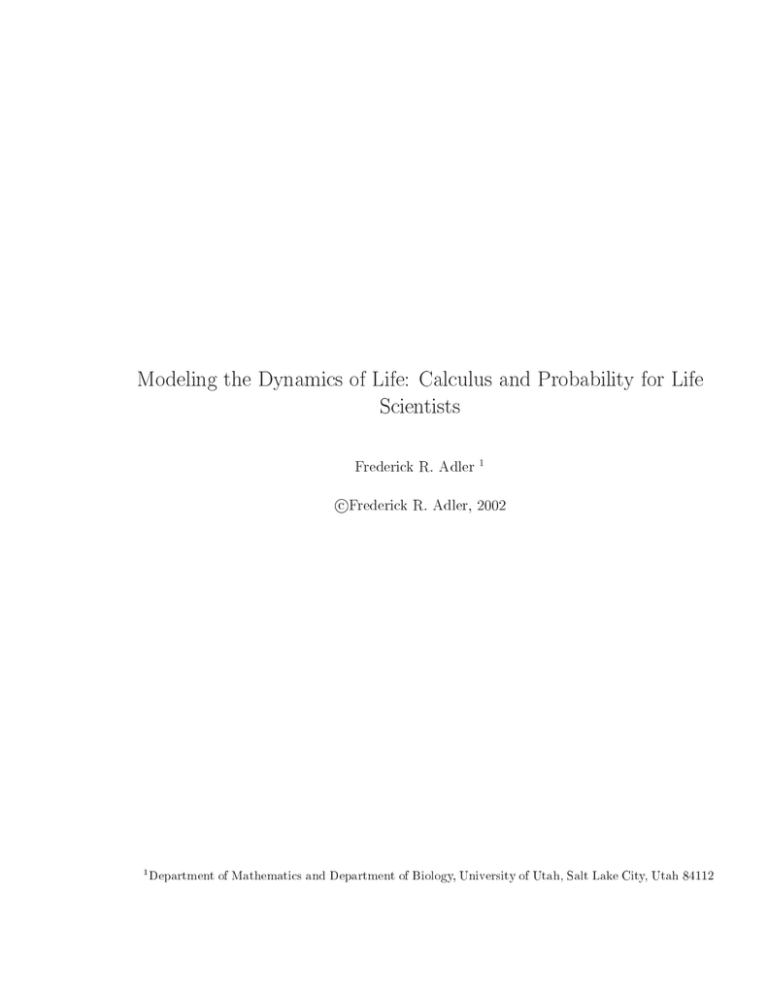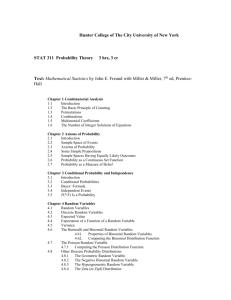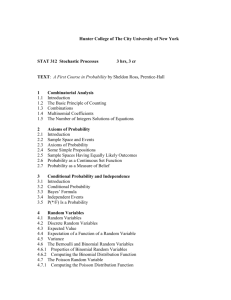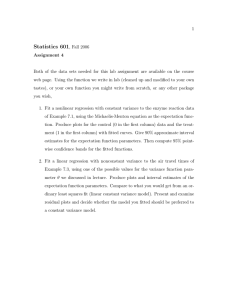Document 11353030
advertisement

Modeling the Dynamics of Life: Calculus and Probability for Life Scientists Frederick R. Adler 1 c Frederick R. Adler, 2002 1 Department of Mathematics and Department of Biology, University of Utah, Salt Lake City, Utah 84112 7.10. SUPPLEMENTARY PROBLEMS FOR CHAPTER 7 1025 7.10 Supplementary Problems for Chapter 7 EXERCISE 7.1 A certain student always arrives the day before the test clutching the practice problems, and asks about each with probability 0.6. a. Under what conditions is the binomial distribution appropriate? b. Under these conditions, what is the probability that the rst problem the student asks about is problem 4? c. What is the probability that this student asks about exactly 4 out of the rst 6? d. What are the expectation and variance of the number asked about if there are 8 practice problems? EXERCISE 7.2 A second student frequently appears after the rst has left. This student also asks about 60% of the problems, but asks about a particular problem with probability 0.8 if the rst student does not. a. Is the behavior of these students independent? How could you tell? b. Give the entire joint distribution. What is the probability that neither asks about problem 5? c. Draw the marginal distribution for the second student. d. Draw the conditional distributions for the second student. e. Find the covariance if asking is worth -1 and not asking is worth 2. EXERCISE 7.3 During a drizzle, raindrops hit a given square meter at a rate of 12.5 per minute. a. What is the expected number of raindrops after 30 seconds? b. What is the probability that exactly 5 raindrops hit in 30 seconds? c. What is the probability that no raindrops hit in 10 seconds? d. If the drizzle lasts one hour, would you be surprised to nd a square meter with exactly 700 wet spots? EXERCISE 7.4 During a particularly wet spring, a rainy day follows a rainy day with probability 0.8, and a rainy day follows a dry day with probability 0.5. a. Write a discrete-time dynamical system describing this model. b. Draw the distributions that describe the weather on one day conditional on the weather of the previous day. c. Find the fraction of rainy days after a long time. d. Draw the joint distribution of weather on consecutive days after a long time. EXERCISE 7.5 A band is composed of 4 guitarists and a drummer. The drummer only knows how to keep a steady beat and each guitarist knows only the A and D chords. Each time the drummer hits the beat, each guitarist plays an A chord with probability 0.75 and a D chord with probability 0.25. a. Under what conditions is the binomial distribution appropriate for describing the number of A chords played on a given beat? b. What is the expectation and variance of the number of guitarists playing that A chord on a given beat? c. If the binomial distribution is appropriate, nd the probability that exactly 2 guitarists hit the A chord. d. Find the probability that all four guitarists play the same chord. e. Find the probability that all four guitarists play the same chord on exactly 2 out of 3 consecutive beats. EXERCISE 7.6 People attending a concert by this band are observed to be leaving at a rate of 3 per minute. 1026 Under what conditions is the Poisson distribution appropriate for describing the number of people who left during a given minute? b. Under these conditions, nd the probability that nobody leaves during a period of length and sketch the function. c. Find the expected number and the variance of people leaving during a given minute. d. Find the probability that exactly 3 people leave during a given minute. e. Find the probability that exactly 3 people leave during a two minute interval. EXERCISE 7.7 The remaining throngs show wild enthusiasm after a song with probability 0.3, mild enthusiasm with probability 0.2, and hurl insults with probability 0.5. The band reduces the volume by 20% in response to wild enthusiasm, by 10% in response to mild enthusiasm, and increases volume by 20% in response to insults. Suppose the volume begins at 100. a. Find the expected volume after one song. b. Would you expect the band to be louder or quieter at the end of a long concert? EXERCISE 7.8 After a particularly demoralizing performance, two guitarists decide to start working together. Recall that they know only two chords, A and D. a. If they began by playing chords independently, give the joint distribution. b. If the second player plays an A with probability 90% when the rst player does, give the joint distribution. c. If playing an A is worth 1 point and a D is worth 0, nd the correlation. d. Draw the marginal and conditional distributions in this case. EXERCISE 7.9 An aspiring worm biologist decides to use a random procedure to stock his lab. He chooses among three catalogues, Baxter, Fisher and Sigma (). He orders from Baxter with probability 0.2, from Fisher with probability 0.7, and from Sigma with probability 0.1. Products are delivered with probability 0.9 from Baxter, 0.95 from Fisher, and 0.8 from Sigma. a. Find the probability a product is delivered. b. Find the probability that a product that was not delivered was ordered from Fisher. c. Find the joint distribution. d. What strategy would maximize the probability of delivery? EXERCISE 7.10 A population switches between phases of growth (G) and decline (D) in subsequent years according to Pr(GjD) = 0 15 and Pr(DjG) = 0 05. The per capita growth rate is 1.2 during growth and 0.7 during decline. a. If the population grows in the rst year, nd the expected size after 2 years. b. If the population grows the rst year, what is the expected time until the rst decline? Sketch the distribution. c. Will this population grow or decline in the long run? d. Find the joint distribution and covariance between years after a long time. EXERCISE 7.11 A staining technique has a 20% chance of success. Let n be the random variable representing the number of successful stainings in attempts. a. What are the conditions for n to have a binomial distribution? What are the parameters? b. Find E( 10 ) and Pr( 10 = 2). a. t : : S n S S S 7.10. SUPPLEMENTARY PROBLEMS FOR CHAPTER 7 1027 EXERCISE 7.12 Under the same conditions as in the previous problem, let be a random variable representing the number of the rst successful attempt. For example, = 2 means that the rst try was a failure and the second a success. a. Graph the probability distribution of . b. Find the expectation and variance of . EXERCISE 7.13 The density of bacterial colonies on a circular dish of radius 3 centimeters is 0.12 colonies per square centimeter. Let be a random variable describing the number of colonies in the whole dish. a. Find the approximate probability of there being a colony in 1 square millimeter. b. Find the expectation and variance of . c. Find the probability of there being no colonies on the whole dish. EXERCISE 7.14 The woodpecker Picoides vilosus enjoys eating both the wood-boring tipulid (Ctenophora vittata) and the hickory bark beetle (Scolytus quadrispinosus). During any given minute, the woodpecker eats one tipulid with probability 0.5 and none with probability 0.5. Independently, during each minute, it eats one beetle with probability 0.25 and none with probability 0.75. a. Sketch the distribution describing the time when the rst beetle is eaten. b. Find the expected time, , when the rst beetle is eaten. c. Find the probability that no tipulids had been eaten at or before , and the expected number of tipulids eaten by time . EXERCISE 7.15 A measurement has normal distribution with mean 10 and variance 9 and an independent measurement has normal distribution with mean 20 and variance 4. a. Find Pr( 11) . b. Find ( + ) and Var( + ). c. Find Pr( + 13). EXERCISE 7.16 Bubbles are produced by a chemical reaction at a rate of 1.8 per minute. Two assiduous students observe 2 bubbles during the rst minute, 1 during the second minute, and fail to pay attention during the third minute because they are studying math. They then knuckle down and pay attention for the next thirty minutes. a. What is the probability that they didn't miss anything during that third minute? What is the probability that they missed 2 or more bubbles? b. What are the expectation and variance of the number of bubbles seen during the 30 minutes of paying attention? c. Write the formula for the probability of exactly 50 bubbles in 30 minutes. d. Two other students pay attention for only 15 minutes and multiply their results by 2. What is the expectation and variance for them? Explain the dierence. EXERCISE 7.17 Because students have proven unable to pay close attention to chemical reactions, the professor designs a new version of the experiment where bubbles do not pop. Students check for bubbles once per minute, record whether there are any (but don't count them), and pop all the ones that are there. The probability of at least one bubble during a minute is 0.83. a. What is the probability that the rst bubble is seen on the fth minute? b. Find the expected number of students in a class of 30 who would see no bubble during the rst 4 minutes. What is the variance? What does it mean? T T T T B B B B B X Y X E X X Y Y X Y 1028 What is the probability that a particular team of students will record bubbles in exactly 25 minutes out of 30? d. Estimate the probability of 25 or more minutes with bubbles during 30 minutes (no factorials allowed). Sketch the probability distribution and the indicate the probability you estimated. EXERCISE 7.18 Students begin measuring two numbers each minute, the number of bubbles and the temperature . can take on only two values 0 and 1, can take on the values 20 and 30. The joint distribution is c. B T B T T T = 20 = 30 =0 0.1 0.07 B =1 0.1 0.73 B Find the marginal distributions. Find and sketch the conditional distribution of when = 20 and when = 30. c. Find the covariance, and say what you would do to make this a more useful statistic. EXERCISE 7.19 Two mathematicians propose models for the growth of an elk population. The rst says that the number increases by , where is a random variable with a Poisson distribution and mean 5. The second says that the population increases by exactly 4% each year. Suppose the actual population begins at 100 and is followed for 10 years, and is found to be year number of elk year number of elk 0 100 6 134 1 103 7 153 2 104 8 155 3 115 9 151 4 111 10 156 5 118 a. b. B B a. c. d. e. T B t b. T t Sketch data that could result from each of the models. What is the expected number of elk and the variance after 10 years according to the models? Which model predicts that the population will grow faster in the long run? What are the strengths and weaknesses of the two models in making sense of the data? If you had to construct a model of this population, what factors would you like to include? 7.10. SUPPLEMENTARY PROBLEMS FOR CHAPTER 7 1179 7.1. c. If she asks about them independently. This is the geometric distribution, with value Pr(T = 4) = 0:43 0:6 = 0:0384. This is the binomial distribution, with value ! 6 Pr(N = 4) = b(4; 6; 0:6) = 4 0:64 0:42 0:311: d. The expectation is np = 4:8 and the variance is np(1 p) = 1:92. a. b. 7.2. a. b. Not independent because the conditional probability is not equal to the unconditional probability. To give the joint distribution for problem 5, let A1 represent the event that the rst student asks, N1 the event that she does not and so forth. A1 N1 A2 0.28 0.32 N2 0.32 0.08 1 Probability 0.8 0.6 0.4 0.2 0 Ask c. Don’t ask 0.8 0.8 0.6 0.4 0.2 e. 0.6 0.4 0.2 0 d. Conditional on first student not asking 1 Probability Probability Conditional on first student asking 1 0 Ask Don’t ask Ask Don’t ask Let P1 be a random variable representing the number of points (-1 or 2) gotten by the rst student, similarly for the second. We have that E(P1 ) = E(P2 ) = 0:6 ( 1) + 0:4 2 = 0:2. Then Cov(P1 ; P2 ) = E(P1 P2 ) E(P1 )E(P2 ) = 0:28 1 + 0:32 ( 2) + 0:32 ( 2) + 0:08 4 0:2 0:2 = 0:72: The negative value makes sense because the second student tends to ask when the rst does not. 1180 7.3. a. b. c. d. Using the Poisson distribution, we nd E(N ) = t = 12:5 0:5 = 6:25. p(5; 6:25) = 6:255 e 6 25 =5! 0:153. In this case = 12:5 0:167 = 2:08. The probability of 0 drops is e 2 08 0:125. The expectedpnumber in an hour is 12:5 60 = 750. The variance is then 750 and the standard deviation is 750 27:4. The value 700 is within two standard deviations of 750, and wouldn't be too surprising. : : 7.4. a. Let p = Pr(rainy on day t). Then t p t+1 = 0:8p + 0:5(1 p ): t t 0.8 0.8 0.6 0.4 0.2 0.4 0 Rain b. Dry Rain Dry The equilibrium is 0.71. R D R +1 0.57 0.145 D +1 0.14 0.145 t d. 0.6 0.2 0 c. Conditional on no rain the previous day 1 Probability Probability Conditional on rain the previous day 1 t t t 7.5. a. b. c. d. They must play independently. Expected number of! A's is 3, the variance is 0.75. b(2; 4; 0:75) = 42 0:752 0:252 0:21. They could either all play A or all play D, so the probability is b(0; 4; 0:75) + b(4; 4; 0:75) = 0:75 + 0:25 0:32: 4 e. This is b(2; 3; 0:32) = ! 3 0:322 0:68 0:21. 2 7.6. a. b. The people leave independently. Probability is e 3 . t 4 7.10. SUPPLEMENTARY PROBLEMS FOR CHAPTER 7 1181 1 Probability 0.8 0.6 0.4 0.2 0 0 c. d. e. 0.5 1 Time 1.5 2 The expected number is E(N ) = 3 and the variance is the same. p(3; 3) = 33 e 3 =3! 0:224. p(3; 6) = 63 e 6 =3! 0:089. 7.7. a. b. The volume is reduced to 80 with probability 0.3, to 90 with probability 0.2, and increased to 120 with probability 0.5. The expectation is 80 0:3 + 90 0:2 + 120 0:5 = 102. Because this is a multiplicative process, we must use the geometric mean. Let V be the random variable representing the change in volume (0.8 with probability 0.3, 0.9 with probability 0.2, and 1.2 with probability 0 .5). Then the geometric mean is eE = eln(0 8)0 3+ln(0 9)0 2+ln(1 2)0 5 = e0 031 1:03: Because this is greater than 1, the band will, on average, become louder by about 3% per song. (ln V ) : : : : : : : 7.8. c. Marginal distribution Conditional on first playing A 1 1 0.8 0.8 Probability b. Supposing that they still play A with probability 0.75 and D with probability 0.25, the joint A1 D1 distribution is A2 0.5625 0.1875 D2 0.1875 0.0625 A1 D1 A2 0.675 0.075 D2 0.075 0.175 The expected value for each is 0.75. The expectation of the product is 0.675, so the covariance is 0.1125. The variance for each is 0.1875, so the correlation is 0.6. Probability a. 0.6 0.4 0.2 0.4 0.2 0 d. 0.6 0 A D A D 1182 Conditional on first playing D 1 Probability 0.8 0.6 0.4 0.2 0 A D 7.9. a. Let D be the event \delivered," B be the event \ordered from Baxter," F be the event \ordered from Fisher," be the event \ordered from Sigma". By the law of total probability, Pr(D) = Pr(DjB)Pr(B) + Pr(DjF)Pr(F) + Pr(Dj)Pr() = 0:9 0:2 + 0:95 0:7 + 0:8 0:1 = 0:925: b. By Bayes' theorem, jF)Pr(F) = 0:95 0:7 0:719: Pr(FjD) = Pr(DPr(D) 0:939 c. d. B F Let N be the event \not delivered." D 0.18 0.665 0.08 N 0.02 0.035 0.02 Ordering everything from Fisher. 7.10. a. b. Pr(G +1 jG ) = 0:95, so it goes from 1.2 to 1.44 with probability 0.95 and from 1.2 to 0.84 with probability 0.05. The expectation is 1.41. This is a geometric distribution, with q = 0:05. The expected time is 20. t t 0.05 Probability 0.04 0.03 0.02 0.01 0 0 10 20 30 40 50 Time c. In the long run, the probability of growth is 0.75 (found from the Markov chain). The geometric mean is 1.049. The population will grow by about 5% per year. 7.10. SUPPLEMENTARY PROBLEMS FOR CHAPTER 7 1183 G D G +1 0.7125 0.0375 d. D +1 0.0375 0.2125 The expectation of each is 1:2 0:75 + 0:7 0:25 = 1:075. The expectation of the product is 1:44 0:7125 + 0:84 0:075 + 0:49 0:2125 = 1:193, and the covariance is 0.0374. t t t t 7.11. a. b. The attempts must be independent. p = 0:2 and n = n. E(S10 ) = np = 2. Pr(S10 = 2) = b(2; 10; 0:2) = 45 0:22 0:88 0:302. 7.12. Probability 0.2 0.15 0.1 0.05 0 0 5 10 Time a. b. 15 20 T has a geometric distribution with q = 0:2. The expectation is 5 and the variance is 20. 7.13. a. b. c. About 0.0012. The area is 28.27 cm2 , so B has a Poisson distribution with = 0:12 28:27 3:39. Both expectation and variance are 3.39. e 3 39 0:034. : 7.14. a. This is a geometric distribution with q = 0:25. Probability 0.2 0.15 0.1 0.05 0 0 2 4 6 8 10 Time b. c. 7.15. Expected time is 4 minutes. Probability no tipulids eaten in 4 minutes is 0:54 = 0:0625. The expected number eaten is 2. 1184 a. b. c. Pr(X 11) = Pr X 3 10 11 3 10 = Pr Z 11 3 10 = Pr(Z 0:33) = (0:33) = 0:630: E(X + Y ) = E(X ) + E(Y )p= 30 and Var(X + Y ) = Var(X ) + Var(Y ) = 13. The standard deviation is 13 = 3:606. X + Y 30 13 30 Pr(X + Y 13) = Pr 605 3:605 3:13 = Pr Z 3:60530 = Pr(Z 4:714) = ( 4:714): This is not on the chart, but the computer says 1:210 6 . 7.16. a. b. c. This follows a Poisson distribution. The probability of 0 is e 2 or more is 0.537. Mean and variance are both 54. 1:8 0:165. The probability of Pr(50 bubbles) = 54 50!e : 50 d. 54 The mean is 54, but the variance is 108. Fewer observations lead to lower certainty. 7.17. a. b. c. d. Only 0.00069. Expect only 0.025 students, or one every 50 times the experiment is run. The variance is also 0.025, meaning that this is pretty uncertain. Using the binomial distribution, this is 0.192. The normal approximation to the binomial has mean 24.9 and variance 4.23. We need to compute the probability that this exceeds 24.5, or that Z > 0:1945, which is 0.5771. 0.2 Probability 0.15 0.1 0.05 0 0 7.18. 5 10 15 20 Number 25 30 7.10. SUPPLEMENTARY PROBLEMS FOR CHAPTER 7 a. 1185 Pr(B = 0) = 0:17, Pr(B = 1) = 0:83 Pr(T = 20) = 0:2, Pr(T = 30) = 0:8. Marginal distribution with T=30 Marginal distribution with T=20 1 1 0.8 Probability Probability 0.8 0.6 0.4 0.6 0.4 0.2 0.2 0 0 0 0 b. c. 1 1 Number of bubbles Number of bubbles The covariance is 0.66. I'd probably convert to the correlation to make it more useful. 7.19. 150 Population 140 Poisson immigration 130 Constant per capita production 120 110 100 0 a. b. c. d. e. 2 4 6 Year 8 10 The Poisson model would have 150 elk, with variance 50. The second model would have 148 elk with no variance. In the long run, the second model would be faster because it grows exponentially rather than linearly. The Poisson model deals better with randomness, but the actual data seem to increase faster as time goes along, more consistent with the second model. I would try to include both stochastic immigration and stochastic reproduction in each year.






